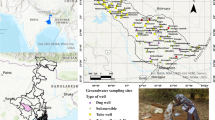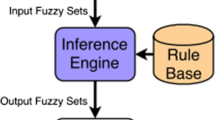Abstract
In this article, a set of clustering algorithms based on Fuzzy Logic and Data Mining are applied, allowing to obtain data in the form of linguistic rules and charts about the behaviour of the Tinto and Odiel river estuary (SW Spain) affected by Acid Mine Drainage (AMD). In order to provide researchers with no skills on data mining techniques an easy and intuitive interpretation, we have developed a computer tool based on fuzzy logic that allows immediate qualitative analysis of the data contained in a data from the estuary water chemical analyses, and serves as a contrast to functioning models previously proposed with classical statistics.






Similar content being viewed by others
References
Andújar JM, Barragán AJ (2005) A methodology to design nonlinear fuzzy control systems. Fuzzy Sets Syst 154(2):157–181
Andújar JM, Bravo JM (2005) Multivariable fuzzy control applied to the physical-chemical treatment facility of a Cellulose factory. Fuzzy Sets Syst 150(3):475–492
Andújar JM, Bravo JM, Peregrín A (2004) Stability analysis and synthesis of multivariable fuzzy systems using interval arithmetic. Fuzzy Sets Syst 148(3):337–353
Aroba J, Ramos I, Riquelme JC (2001) Application of machine learning techniques to software project management. ICEIS 2001 (III International Conference on Enterprise Information Systems), Setubal (Portugal), p 433
Azcue JM (1999) Environmental impacts of mining activities. Springer, Heidelberg
Bezdek JC (1981) Pattern recognition with fuzzy objective function algorithm. Plenum, New York
Borrego J, Morales JA, Pendón JG (1993) Holocene filling of an Estuarine Lagoon along the Mesotidal Coast of Huelva: the Piedras River Mouth, southwestern Spain. J Coast Res 9:242–254
Borrego J, Morales JA, de la Torre ML, Grande JA (2002) Geochemical characteristics of heavy metal pollution in surface sediments of the Tinto and Odiel river estuary (Southwestern Spain). Environ Geol 41:785–796
Braungardt CB, Achterberg EP, Nimmo M (1998) Behavior of dissolved trace metals in the Rio Tinto/Rio Odiel Estuarine System. In: Morales JA, Borrego J (eds) European land–ocean interaction studies, Second Annual Scientific Conference, p 51 (abstracts)
Commonwealth of Pennsylvania (1994) Water quality assessment in Western Pennsylvania Watershed
Cruzado A, García HE, Velásquez ZR, Grimaldo NS, Bahamon N (1998) The Ria de Huelva (SW Spain). Hydrography and general characteristics. In: Morales JA, Borrego J (eds) European land–ocean interaction studies. Second Annual Scientific Conference, p 83 (abstracts)
Davis RA Jr, Welty AT, Borrego J, Morales JA, Pendón JG, Ryan JG (2000). Rio Tinto estuary (Spain): 5,000 years of pollution. Environ Geol 39:1107–1116
Dogan PA (1999) Characterization of mine waste for prediction of acid mine drainage. In: Azcue JM (ed) Environmental impacts of mining activities. Springer, Heidelberg, pp 19–38
Elbaz-Poulichet F, Dupuy C (1999) Behaviour of rare earth elements at the freshwater-seawater interface of two acid mine rivers: the Tinto and Odiel (Andalucía, Spain). Appl Geochem 14(8):1063–1072
Elbaz-Poulichet F, Leblanc M (1996) Transfer de métaux d`une province minière á l`océan par des fleuves acides (Rio Tinto, Espagne). CR Acd Sci Paris 322:1047–1052
Elbaz-Poulichet F, Braungardt CB, Achterberg EP, Morley NH, Cossa D (1999a) A synthesis of the results of TOROS and CANIGO projects on metal contamination in the Tinto-Odiel rivers (Southern Spain) and the Gulf of Cadiz. In: Pacyma JM, Kremer H, Pirrone N, Barthel K (eds) Socioeconomic aspects of fluxes of chemicals into marine environment, pp 1001–1109
Elbaz-Poulichet F, Morley NH, Cruzado A, Velásquez Z, Achterberg EP, Braungardt CB (1999b) Trace metal and nutrient distribution in an extremely low pH (2.5) river-estuarine system, the Ria of Huelva (South-West Spain). Sci Total Environ 227:73–83
Elbaz-Poulichet F, Dupuy C, Cruzado A, Velásquez Z, Achterberg E, Braungardt C (2000) Influence of sorption processes by iron oxides and algae fixation on arsenic and phosphate cycle in an acidic estuary (Tinto river, Spain). Water Resour 34(12):3222–3230
EMCBC (1996) The perpetual pollution machine. Acide mine drainage. B.C. Mining Control, Canada, pp 1–6
Fallad UM, Uthurusamy R (1996) Data mining y KDD. Commun ACM 39(11)
Feasby DG, Tremblay GA, Weatherell CJ (1997). A decade of technology improvement to the challenge of acid mine drainage- a Canadian perspective. In: Fourth international conference on acid rock drainage, vol 1, pp i–ix. Vancouver, Canada. Proceedings
Förstner U, Wittmann GTW (1983). Metal pollution in the aquatic environment. Springer, Heidelberg
Grande JA, Borrego J, Morales JA (2000) A study of heavy metal pollution in the Tinto-Odiel estuary in southwestern Spain using factor analysis. Environ Geol 39(10):1095–1101
Grande JA, Borrego J, de la Torre ML, Sáinz A (2003a) Application of cluster analysis to the geochemistry zonation of the estuary waters in the Tinto and Odiel rivers Huelva, Spain) Environ Geochem Hlth 25:233–246
Grande JA, de la Torre ML, Sáinz A (2003b) Odiel River: acid mine drainage and current characterization by means of univariate analysis. Environ Int 29:51–59
Grande JA, Borrego J, Morales JA, de la Torre ML (2003c) A description of how metal pollution occurs in the Tinto-Odiel rias (Huelva- Spain) through the application of cluster analysis. Mar Pollut Bull 46:475–480
Grande JA, Sáinz A, Beltrán R, González F, de la Torre ML (2003d) Caracterización de procesos de drenaje ácido de mina en la Faja Pirítica Ibérica sobre un embalse para abastecimiento público. Proceedings of VIII Congreso de Ingeniería Ambiental. Bilbao. Spain, pp 443–452
Grande JA, González F, Sáinz A, de la Torre ML, Beltrán R, Sánchez D (2003e) Aporte de metales pesados a la red fluvial procedentes de la actividad minera en el SW de España, vol 2. In: Proceedings of III Congreso Argentino de Hidrogeología. Rosario. Argentina, pp 331–343
Holsheimer M, Siebes A (1994) Data mining: the search for knowledge in Databases. Report CS-R9406, CWI Amsterdam
Kruse R, Klawonn F, Höppner F (1999) Fuzzy cluster analysis: methods for classification, data analysis and image recognising. Wiley, New York
Lu R, Lo S (2002) Diagnosing reservoir water quality using self-organizing maps and fuzzy theory. Water Res 36:2265–2274
Nebel BJ, Wrigth RT (1999) Ciencias ambientales. Ecología y desarrollo sostenible. Prentice Hall, México
Nicholson RV (1994) Iron-sulfide oxidation mechanism: laboratory studies. In: Jambor JL, Blowes DW (eds) The Environmental Geochemistry of Sulfide Mine-Wastes, Mineralogical Association of Canada Short Course Handbook. Canada, vol 22, pp 163–182
Ong C, Huang J, Tzeng G (2004) Multidimensional data in multidimensional scaling using the analytic network process. Pattern Recog Let 26(6):755–767
Pearson K (1901) On lines and planes of closets fit to systems of points in space. Philos Mag, ser. 6, 559–572
Sáinz A, Grande JA, de la Torre ML, Sánchez-Rodas D (2002) Characterisation of sequential leachate discharges of mining waste rock dumps in the Tinto and Odiel rivers. J Environ Manage 64(4):345–353
Sáinz A, Grande JA, de la Torre ML (2003) Analysis of the impact of local corrective measures on the input of contaminants from the Odiel river to the ria of the Huelva (Spain). Water Air Soil Poll 144:35–389
Sáinz A, Grande JA, de la Torre ML (2004) Characterisation of heavy metal discharge into the Ria of Huelva. Environ Int 30:557–566
Simmons HB (1955) Some effects of upland discharge on estuarine Hydraulic. Proc ASCE 81:1–20
Sugeno M, Yasukawa A (1993) A Fuzzy-Logic Based approach to qualitative Modeling. IEEE Trans Fuzzy Syst 1:7–31
Travesi A, Gasco C, Pozuelo M, Palomares J, García MR, Pérez del Villar L (1997) Distribution of natural radioactivity within an estuary affected by release from phosphate industry. In: Desmet G (ed) Freshwater and estuarine radioecology, Elsevier, Amsterdam, pp 267–279
USEPA (1994) Water quality standards handbook, 2nd edn. Washington DC, U.S. Environmental Protection Agency. Office of Water. EPA-823-B-94–005
Von Altrock C (1995) Fuzzy logic and neurofuzzy applications explained, Prentice-Hall, New York
Ward M, LeBlanc J, Tipnis R (1994) N-land: a graphical tool for exploring N-dimensional data. In: Computer graphics international conference. Melbourne, Australia
Weatherell CJ, Feasby DG, Tremblay GA (1997) The mine environment natural drainage program. In: Proceedings of the PMI 97, 28th Annual Seminars and Symposium, Chicago
Yen J, Langari R (1999) Fuzzy logic: intelligence, control and information, Prentice-Hall, New York
Younger P, Banwart S, Hedin R (2002) Mine water: hydrology, pollution, remediation. Kluwer, Dordrecht, Netherlands
Zadeh LA (1965) Fuzzy sets, information and control, vol 8, pp 338–353
Zaïane OR (1999) Principles of knowledge discovery in databases. CMPUT690, Department of Computing Science, University of Alberta
Sources of unpublished materials
Aroba J (2003) Advances en la toma de decisiones en proyectos de desarrollo de software, PhD thesis, University of Sevilla, Spain
Borrego J (1992) Sedimentología del estuario del Río Odiel, Huelva, S.O. España. PhD thesis, University of Sevilla, Spain
Sáinz A (1999) Estudio de la contaminación química de origen minero en el río Odiel. PhD thesis. University of Huelva, Spain
Acknowledgments
The present study is a contribution of the CICYT-REN2002-01897/HID and CICYT-TIN2004-006689-C03-03 projects, granted by The Spanish Ministry of Science and Technology, and the TOROS project (contract ENV4-CT96-0217 of the ELOISE E.C. project).
Author information
Authors and Affiliations
Corresponding author
Rights and permissions
About this article
Cite this article
Aroba, J., Grande, J.A., Andújar, J.M. et al. Application of fuzzy logic and data mining techniques as tools for qualitative interpretation of acid mine drainage processes. Environ Geol 53, 135–145 (2007). https://doi.org/10.1007/s00254-006-0627-0
Received:
Accepted:
Published:
Issue Date:
DOI: https://doi.org/10.1007/s00254-006-0627-0




